With the rise of influencers on social media platforms, marketers have started collaborating with them to reach millennials, and to a lesser degree Gen Z.
You’ve likely heard of millennials before, especially if you work in the marketing space. But if not, they are the generation of people born between 1980 and 2000.
In general, millennials are a group of people who were taught to reason and question. This particular generation has seen the growth of technology and is highly comfortable with it.
This age group of people is the first ones to regularly use the internet as well as cell phones and innovations such as Kindles and iPads. And they have the highest purchasing power too.
Why is it important to reach millennials?
A study by Millennial Marketing found that 25% of the total US population is part of the millennial generation.
They also make up 21% of consumer discretionary purchases, which equates to a direct purchasing power of about a trillion dollars.
Here are some more powerful statistics about them that may come as a surprise:
- Almost 50% of the millennial generation report that they consider using brands that actively support social causes.
- 37% of the millennial generation is willing to pay more for products or services that support a cause.
- 80% of them want to be entertained by brands.
Millennials and Gen Z have very different worldviews. Traditional advertising simply does not work on this kind of audience like it once did on the baby boomers.
Why, you wonder?
Millennials and Gen Z find traditional digital advertising pushy, spammy, or intrusive. Naturally, those “brilliantly created ads” by marketing geniuses are facing the wrath of ad blockers.
There are now 615 million mobile devices that use adblocker. This makes influencing purchases a tricky job when it comes to targeting millennials, not to mention Gen Z.
Table of Contents
Millennials and Influencers: How to Leverage Them For Your Influencer Campaigns
That’s exactly why influencer marketing and millennials have become so synonymous with the digital marketing industry recently.
Being real people and being knowledgeable in their fields, social influencers know how to appeal to this age group, and compel them to make a purchase decision.
Below are five ways that will help your brand reach millennials effectively using influencer marketing.
#1. Create A Message
Does your brand stand for a social cause? Does it believe in eco-friendliness, or makes a charitable donation every time a purchase is made?
The previously-cited Millennial Marketing study revealed that they want to buy from brands that are concerned about a good cause.
The good news is that this is one of the many things that millennials and social influencers have in common.
This is perhaps because many social influencers are millennials themselves.
Like we mentioned earlier, millennials belong to that section of society who are extremely well-informed.
Winning them over to your brand is certainly not going to be easy, but influencer campaigns can help.
However, because most of them believe in social causes, you need to work on messaging that they can relate to.
For example, maybe your brand had humble beginnings, and you now create products that improve people’s lives.
Whatever be the cause, you should share this with millennials so that they are genuinely interested in following your brand, especially on social media.
Collaborating with influencers who stand for such causes can greatly help you win over millennials and gain their trust.
But how do you find cause-oriented influencers?
An influencer marketing platform like Heepsy can help you identify influencers who share the values of your target audience. I
f you team up with such influencers, the messaging in your marketing strategy will be credible and compelling.
Influencers are loved by their audiences because of their credibility and authentic content.
Hence, the audience considers their opinion when it comes to making a purchase.
Example: Aerie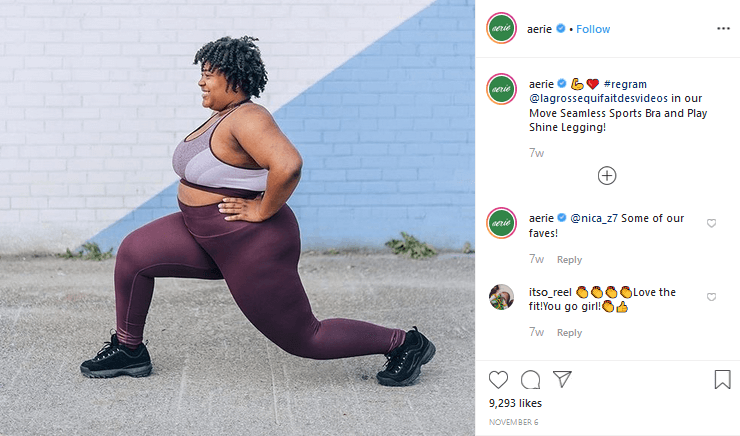
Here is a influencer marketing great example from the American lingerie retail company, Aerie.
They often collaborate with micro and nano-influencers on social media to spread awareness about the body positivity movement.
They encourage people to embrace their body types and be comfortable in their own skin.
By tackling a social issue on social platforms, they are taking a bold stance which is likely to strike a chord with millennials and even Generation Z.
#2. Instagram Stories
When Instagram Stories was launched, it wasn’t expected that it would become a big hit globally.
This is simply because, at that time, most social media sites like Facebook and Snapchat already had this option available.
Want to know a surprising fact?
In one year, Instagram Stories saw 200 million people using it every month.
People love this social media feature and it has become a very successful method for brands to promote their products on social media.
With endless creative possibilities, Instagram Stories have become an opportunity for influencer marketing to target millennials on social media.
Example: Boutique Rugs
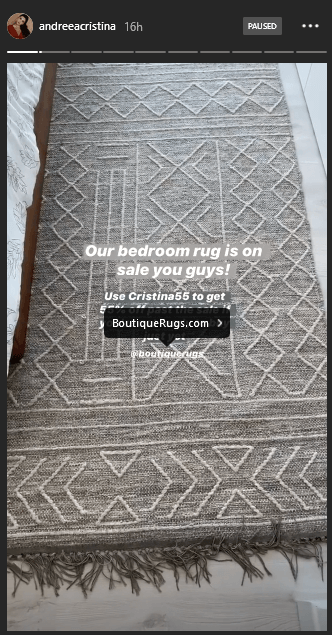
Here, Boutique Rugs collaborated with an Instagram influencer, Andrea Christina, to promote their latest addition to their rug collection.
In her Instagram Story, Andrea laid the carpet in her bedroom and highlighted its USP.
From her Story, users could be easily redirected to the company’s website. She even added a code that her followers could use to get a discount.
Want a pro tip?
If your Stories have stunning visual content, they can make a greater impact on millennials, who are known to respond well to visuals.
I like to use PixTeller to create great stills, videos, and collages for my Stories. Their Animation Maker is especially useful for crafting animated GIFs that are a hit on social media.
Influencers and influencer marketing experts effectively make use of their Instagram Stories to engage with their followers.
So if you’re wondering how to make your influencer marketing campaign successful, ask your influencers to leverage Instagram Stories.
#3. Rewards And Incentives
Providing incentives and branded rewards can help you drive conversions among millennials and influencer marketing is the perfect channel to promote them.
These offers can seem like VIP treatment to them.
By partnering with influencers to promote your brand with special discount codes, you can effectively target millennials.
How does this work?
When you use this influencer marketing approach, the millennials you’re targeting are not just receiving rewards but receiving them from their favorite influencers.
That certainly creates a better impact on their brand loyalty and on your conversion rates.
Example: Daniel Wellington
Here we see popular celebrity and model Kendall Jenner promoting the brand Daniel Wellington.
Kendall is wearing a Daniel Wellington watch and cuff and has provided a special discount code to her followers.
This influencer marketing tactic not only boosts brand awareness and credibility but also encourages millennials to make a purchase.
My favorite giveaway tool is Vyper. Using the tool, you can create great giveaways and earn referral traffic, sales, and new followers.
You can also create rewards programs to incentivize new and potential followers to engage with your content more actively.
For capturing the contact details of program participants, Vyper lets you embed registration forms in your program.
Plus, you’ll get a landing page and thank you page for each campaign. All coding-free.
#4. User-Generated Content (UGC)
According to an Olapic study, 56% of consumers would be more interested in buying a product that they have seen in a positive or relatable photo posted by another consumer.
User-generated content has become a major tool for brands in marketing their products.
If your brand is not utilizing this aspect of influencer marketing, you’re missing out on considerable opportunities of winning over millennials.
A study by CrowdTap showed that millennials spend 30% of that time looking at user-generated content.
The study further shows that 71% of millennials refer to social media sites at least once every day.
This makes them prominent figures when it comes to loyalty-based promotions of your brand.
So user-generated content should be a vital part of your attempt to target millennials and influencers can play an important role in this.
The right influencers can urge their audience to create content featuring your products.
And in the process, you will be able to reach other millennials who are following these users.
Example: Daniel Wellington
We mentioned earlier how Daniel Wellington uses influencers to promote their watches using discount codes as incentives.
The watch brand combines this influencer marketing strategy with user-generated content to make their influencer campaigns even more effective.
They run photo contests regularly inviting people to post photos of their Daniel Wellington watches with the hashtag #DWPickoftheDay.
They then feature the winners of this contest on their Instagram page and give them a free watch.
Here’s an example of a post by an influencer encouraging their followers to create user-generated content for Daniel Wellington.
#5. Social Media Takeovers
Social media takeovers are a great way to boost your brand awareness and visibility.
They involve giving control of your social media pages over to an influencer for a limited period of time.
You allow them to post photos, videos, and other content on your behalf as part of your influencer marketing efforts.
The reason?
With the involvement of an influencer, you can attract their followers to your channel. It can do wonders to boost your engagement rate.
What’s more, influencer content can add some diversity to your profile.
Example: Wilton Cakes
Wilton Cakes, an Illinois-based brand organizes Instagram takeovers with influencers on a regular basis.
Recently, they collaborated with baker and influencer, Jenny Keller. During the takeover, she shared a recipe for a square sheet cake with their followers.
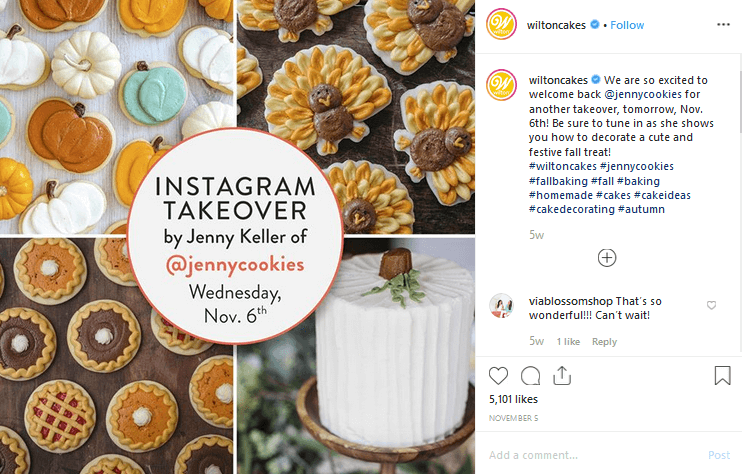
#6. Meme Marketing
Millennials love memes. They are easy-to-consume, engaging, and have the potential to go viral.
As a marketer, you can also use memes as branding tools. If you do it right, you can strike a chord with millennials.
To get the most out of your meme marketing campaigns, you can also collaborate with influencers.
They create content on a regular basis, so they may be able to help you come up with creative ideas.
The key to succeeding with this strategy is to create shareworthy, memorable, and relatable content.
To churn out fresh memes, you’ll need to keep an eye on trending topics on social media. You should also check out the most popular memes for millennials.
You can get inspiration from them and create your own meme. Or you could also choose an existing one and incorporate your brand into the meme.
Need meme ideas?
You can use a tool like ProWritingAid to learn about the latest content topics for making your memes.
The tool searches for quotes and royalty-free images that can be put together to create eye-catching memes.
Using the tool, you can rehash old memes or create fresh ones.
Example: Gucci
An example of good meme marketing is the #TWFGucci campaign. They collaborated with various artists to create memes for their brand.
In the screenshot below, you can see a meme featured on their Instagram profile.
Created by freelance surrealist artist, Polly Nor, it promotes their brand in a subtle manner.
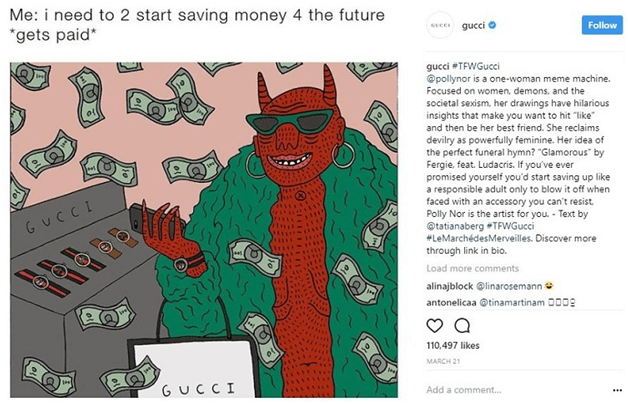
FAQs
Q1. Do millennials trust influencers?
A. Yes, millennials trust influencers on social media very much. In fact, a survey revealed that 50% of millennials trust the influencers they follow on social media.
And when it comes to social media shoppers, 82% of millennials and Gen Z trust influencers.
Q2. How many millennials follow influencers?
A. A vast majority of millennials follow influencers on social media sites.
According to a survey, about 72% of millennials and Gen Z follow social media influencers.
Q3. What is the best way to market to millennials?
A. Influencer marketing is one of the best ways of marketing to millennials.
This is because a vast majority of them follow influencers and a great segment of them even trust influencers to provide the right product recommendations.
Q4. What are the core values of millennials?
A. Some of the core personal values of millennials are:
- Place importance on relationships with superiors
- Value motivations
- Passion for learning more
- Achievement-oriented
- Seek new challenges
- Not afraid to question authority
Q5. How do you target millennials?
A. To reach and engage millennials, you should try these tactics:
- Create a message through influencers that millennials can relate to.
- Leverage Instagram Stories.
- Use rewards and incentives.
- Encourage user-generated content (UGC).
- Organize social media takeovers.
- Leverage meme marketing.
Q6. Which social media platform is most popular with millennials?
A. Instagram and Facebook are two of the most popular social platforms among millennials.
77% of American millennials said that they use Facebook daily while 70% of them said that they use Instagram.
Q7. Why do you need influencers to target millennials?
A. One of the biggest reasons why you need influencers to target millennials is the fact that a large chunk of millennials trust influencers because they are real people.
By working with the right influencers, you’ll be able to gain the trust of a vast majority of millennials too.
Ready to Get Started?
Brands need to shift from traditional advertising methods that cater to baby boomers to influencer marketing as the millennial generation lives on the internet and social media in general.
When marketing to millennials, as well as Gen Z, you should focus on understanding their tastes and preferences.
They have a good sense of popular trends, and can quickly identify if an influencer is credible or not.
The strategies mentioned above will help you leverage your influencers effectively to target millennials.
Just make sure that you find the right influencers.
Remember, millennials are the ones who have the highest purchasing power, more so than baby boomers and Gen Z.
So being able to influence their purchases will be great for your business.
Can you think of any more strategies to target millennials using influencer marketing? Feel free to share them in the comments below.
Also, if you are looking for an Influencer Marketing Consultation for your brand then feel free to contact me.


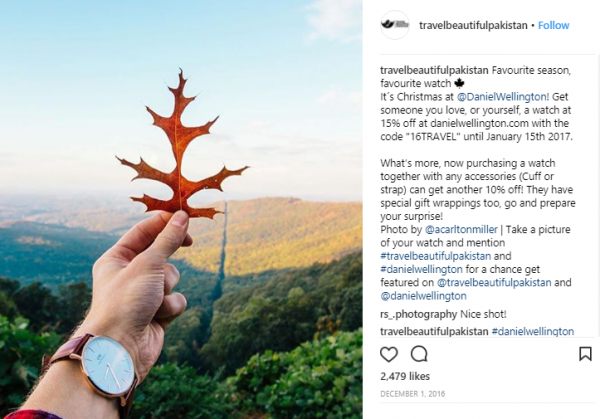

Related Articles
Influencer Outreach Tools: 21 Time-Saving Platforms You Need to Know
How Do You Amplify Influencer Content?
How to Conduct Influencer Outreach That Gets Stunning Results
17 of the Best Snapchat Influencers Who Can Boost Your Reach
How to Become an Influencer in 2024 [A Beginner’s Guide]
40+ Top Influencer Marketing Agencies in 2024